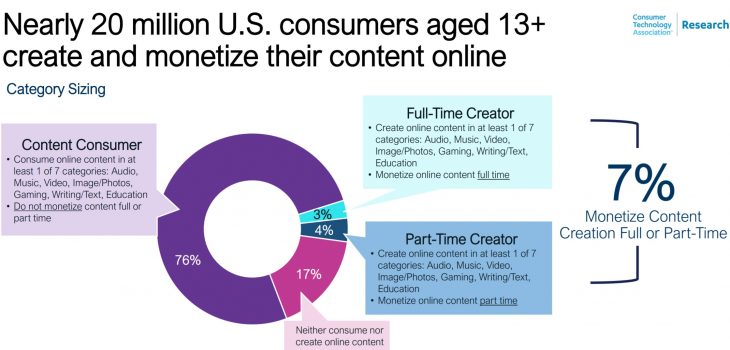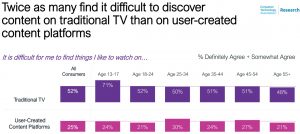
By John Bugailiskis
LAS VEGAS – User-created content (UGC) from independent creators now accounts for 39% of weekly media hours consumed by Americans compared to 61% for traditional studio media and that share will likely increase.
More troubling for broadcasters is that more than twice as many viewers found it more difficult to find content on traditional TV than on UGC platforms such as YouTube, Instagram and TikTok (see chart below).
These findings, shared at CES 2022, come from a just released study from the Consumer Technology Association (CTA) that examined U.S. content creator trends. The report, Exploring the Creator Economy, found that six in 10 respondents report watching more UGC now versus a few years ago.
Not surprisingly, hours dedicated to watching UGC is highly dependent on age, with teens spending 56% of their time watching compared to just 22% among consumers aged 55+, the report found.
The quantitative study was carried out to an online sample of 2,084 respondents (aged 13+) between Oct. 26 and Nov. 9, 2021. CTA employed the services of YouGov to host and provide a nationally representative panel of U.S. consumers who have a smartphone or cellular phone. It claims a margin of sampling error at 95% confidence for aggregate results is +/-3%.
The report found that the Covid-19 pandemic has further accelerated the shift from traditional TV, with 42% of all respondents indicating they now view more UGC since last year.
In addition, the research found that nearly 7% of U.S. consumers 13 and older (more than 20 million people) are actively monetizing content in some way online (see above), either on a part- or full-time basis. Those who identified themselves as full-time content creators reported generating an average of $768 per month.
Niche genres such as gaming, audio and music have fewer content creators overall, but a larger proportion who are monetizing their content. More than one-third of those who engage with UGC pay to support the creators by subscribing to paid content, or via tips found.
The report recommends that for content platforms to compete with UGC they need to “empower younger consumers with tools needed to join the creator economy themselves to make the content that their peers consume. Make the monetization process safe, easy and accessible for younger consumers just starting their creator career.”
The number one challenge creators face is making enough money to make it worth their while. “There is an opportunity for third party companies to help creators optimize their revenue sources or introduce new creative sources that might otherwise be left untapped. Simplifying the revenue generating process would give creators the time they need to express themselves and create content rather than worrying about the business side,” the study concluded.




